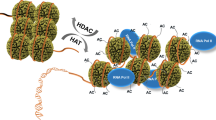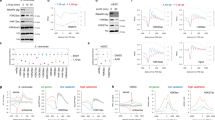Abstract.
In the nucleus, DNA is tightly packaged into higher-order structures, generating an environment that is highly repressive towards DNA processes such as gene transcription. Acetylation of lysine residues within proteins has recently emerged as a major mechanism used by the cell to overcome this repression. Acetylation of non-histone proteins, including transcription factors, as well as histones, appears to be involved in this process. Like phosphorylation, acetylation is a dynamic process that can regulate protein-DNA and protein-protein interactions. Moreover, a conserved domain, the bromodomain, has been implicated in the binding of acetylated peptides, suggesting a role for acetylation in intracellular signalling.
Similar content being viewed by others
Author information
Authors and Affiliations
Rights and permissions
About this article
Cite this article
Bannister*, A., Miska, E. Regulation of gene expression by transcription factor acetylation . CMLS, Cell. Mol. Life Sci. 57, 1184–1192 (2000). https://doi.org/10.1007/PL00000758
Issue Date:
DOI: https://doi.org/10.1007/PL00000758




